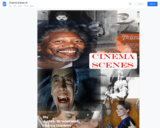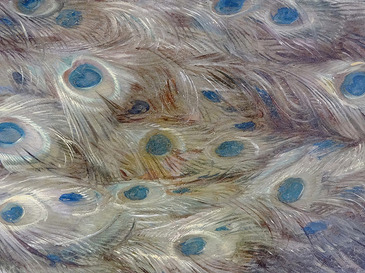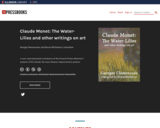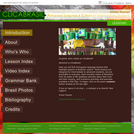
a textbook on the history of film
- Subject:
- Arts and Humanities
- Material Type:
- Textbook
- Author:
- Patsy daniels
- colleenn mccready
- laura sherrill
- stuart lenig
- judith broadbent
- Date Added:
- 06/13/2022


a textbook on the history of film

This course’s aims are two-fold:
to offer students the theoretical and practical tools to understand how and why cities become torn by ethnic, religious, racial, nationalist, and/or other forms of identity that end up leading to conflict, violence, inequality, and social injustice; and
to use this knowledge and insight in the search for solutions
As preparation, students will be required to become familiar with social and political theories of the city and the nation and their relationship to each other. They also will focus on the ways that racial, ethnic, religious, nationalist or other identities grow and manifest themselves in cities or other territorial levels of determination (including the regional or transnational). In the search for remedies, students will be encouraged to consider a variety of policymaking or design points of entry, ranging from the political- institutional (e.g. forms of democratic participation and citizenship) to spatial, infrastructural, and technological interventions.

Do you want to think about ways to help solve New Orleans’ problems? CityScope is a project-based introduction to the contemporary city. “Problem solving in complex (urban) environments” is different than “solving complex problems.” As a member of a team, you will learn to assess scenarios for the purpose of formulating social, economic and design strategies to provide humane and sustainable solutions. A visit to New Orleans is planned for spring break 2007.

This class is intended to introduce students to understandings of the city generated from both social science literature and the field of urban design. The first part of the course examines literature on the history and theory of the city. Among other factors, it pays special attention to the larger territorial settings in which cities emerged and developed (ranging from the global to the national to the regional context) and how these affected the nature, character, and functioning of cities and the lives of their inhabitants. The remaining weeks focus more explicitly on the theory and practice of design visions for the city, the latter in both utopian and realized form. One of our aims will be to assess the conditions under which a variety of design visions were conceived, and to assess them in terms of the varying patterns of territorial “nestedness” (local, regional, national, imperial, and global) examined in the first part of the course. Another will be to encourage students to think about the future prospects of cities (in terms of territorial context or other political functions and social aims) and to offer design visions that might reflect these new dynamics.

Using film as a lens to explore and interpret various aspects of the urban experience in both the U.S. and abroad, this course presents a survey of important developments in urbanism from 1900 to the present day, including changes in technology, bureaucracy, and industrialization; immigration and national identity; race, class, gender, and economic inequality; politics, conformity, and urban anomie; and planning, development, private property, displacement, sprawl, environmental degradation, and suburbanization.

This course investigates the relationship between urban architecture and political, social, and cultural history of Athens in the 5th and 4th centuries BC. It surveys and analyzes archeological and literary evidence, including the sanctuary of Athena on the Acropolis, the Agora, Greek houses, the histories of Herodotus and Thucydides, plays of Sophocles and Aristophanes, and the panhellenic sanctuaries of Delphi and Olympia.

This course is a service-learning, project-based studio course that focuses on collaborative design of civic media. Students will work in diverse teams with community partners to create civic media projects grounded in real-world community needs. This course covers co-design and lean UX methods, and best practices for including communities in iterative stages of project ideation, design, prototyping, testing, launch, and stewardship. Students should have an interest in collaboration with community-based organizations.

This course centers on mechanisms of civilian control of the military. Relying on the influential texts of Lasswell, Huntington, and Finer, the first classes clarify the basic tensions between the military and civilians. A wide-ranging series of case studies follows. These cases are chosen to create a field of variation that includes states with stable civilian rule, states with stable military influence, and states exhibiting fluctuations between military and civilian control. The final three weeks of the course are devoted to the broader relationship between military and society.

This course surveys the social science literature on civil war. Students will study the origins of civil war, discuss variables that affect the duration of civil war, and examine the termination of conflict. This course is highly interdisciplinary and covers a wide variety of cases.

Although attention will be devoted to the causes and long-term consequences of the Civil War, this class will focus primarily on the war years (1861-1865) with special emphasis on the military and technological aspects of the conflict. Four questions, long debated by historians, will receive close scrutiny:
What caused the war?
Why did the North win the war?
Could the South have won?
To what extent is the Civil War America’s “defining moment”?

This course explores the causes, course, and consequences of the American Civil War, from the 1840s to 1877. The primary goal of the course is to understand the multiple meanings of a transforming event in American history. Those meanings may be defined in many ways: national, sectional, racial, constitutional, individual, social, intellectual, or moral. Four broad themes are closely examined: the crisis of union and disunion in an expanding republic; slavery, race, and emancipation as national problem, personal experience, and social process; the experience of modern, total war for individuals and society; and the political and social challenges of Reconstruction.

Using the American Civil War as a baseline, the course considers what it means to become “modern” by exploring the war’s material and manpower needs, associated key technologies, and how both influenced the United States’ entrance into the age of “Big Business.” Readings include material on steam transportation, telegraphic communications, arms production, naval innovation, food processing, medicine, public health, management methods, and the mass production of everything from underwear to uniforms—all essential ingredients of modernity. Students taking the graduate version must complete additional assignments.

Roman Literature of the Golden Age of Augustus Caesar, produced during the transition from Republican to Imperial forms of government, was to have a profound and defining influence on Western European and American societies. These writings ultimately established lasting models of aesthetic refinement, philosophical aspiration, and political ambition that continue to shape modern cultures. This class will be exploring the Golden Age of Latin Literature from an historical perspective in order to provide an intensive examination of the cultural contexts in which these monumental works of classical art were first produced. Readings will emphasize the transition from a Republican form of government to an Empire under the rule of Augustus Caesar and the diversity of responses among individual authors to the profound structural changes that Roman society was undergoing at this time. Particular attention will be devoted to the reorganization of society and the self through textuality, the changing dimensions of the public and the private, the roles of class and gender, and the relationship between art and pleasure. Writings covering a wide variety of literary genres will include the works of Caesar, Cicero, Catullus, Livy, Virgil, Horace, and Ovid, with additional readings from Cassius Dio for background.

This course is an introduction to the history, theory, practice, and implications of rhetoric, the art and craft of persuasion through
Analyzing persuasive texts and speeches
Creating persuasive texts and speeches
Through class discussions, presentations, and written assignments, you will get to practice your own rhetorical prowess. Through the readings, you’ll also learn some ways to make yourself a more efficient reader, as you turn your analytical skills on the texts themselves. This combination of reading, speaking, and writing will help you succeed in:
learning
to read and think critically
techniques of rhetorical analysis
techniques of argument
to enhance your written and oral discourse with appropriate figures of speech
some techniques of oral presentation and the use of visual aids and visual rhetoric.

This course is an introduction to three of the major genres of traditional Chinese literature—poetry, fiction and drama, with a focus on vernacular fiction. We will read translations of a number of the “masterworks” of Chinese literature. We will also examine the intertextuality between these genres — how poetry blends into narrative, how fiction becomes drama, and drama inspires fiction. Through reading these selected works of traditional Chinese literature, we will examine some of the major features of traditional Chinese society: religious and philosophical beliefs, the imperial system and dynastic change, gender relations, notions of class and ethnicity, family, romance and sexuality. All works are read in translation; no language background is necessary.

This course will introduce you to the Western philosophical tradition through the study of thinkers such as Plato, Aristotle, Descartes, Cavendish, Hume, and Kant. You’ll grapple with questions that have been significant to philosophy from its beginnings: Questions about the nature of the mind, the existence of God, the foundations of knowledge, and the good life. You’ll also observe changes of intellectual outlook over time, and the effect of scientific, religious, and political concerns on the development of philosophical ideas.

Short Description:
A new and annotated translation of the French Prime Minister’s memoir of his friend, the most famous Impressionist painter.
Long Description:
In 1928, the former French Prime Minister Georges Clemenceau published Claude Monet: Les Nymphéas (The Water-Lilies), a memoir of his longtime friend. Bruce Michelson has produced a new English translation, presented here with useful notes and illustrations.
Michelson’s translations of three short essays on art by Clemenceau, originally published by La Justice in the late XIX c., are included as appendices.
Published by Windsor & Downs Press, part of the Illinois Open Publishing Network (IOPN). IOPN is a project of the University Library, University of Illinois at Urbana-Champaign.
Word Count: 40724
ISBN: 978-1-946011-00-8
(Note: This resource's metadata has been created automatically as part of a bulk import process by reformatting and/or combining the information that the author initially provided. As a result, there may be errors in formatting.)

It may seem strange to begin a logic textbook with this question. ‘Thinking’ is perhaps the most intimate and personal thing that people do. Yet the more you ‘think’ about thinking, the more mysterious it can appear. Do our thoughts appear in our minds because of the electro-chemical workings of our brains? Or do thoughts come from something that can’t be described by science, such as a soul? Are there deeper levels to the scientific explanation of thinking, for instance involving sub-atomic quantum effects? Or do our thoughts come from pure magic? Does it fit the case to say that our thoughts ‘come from’ some place? Or that they ‘appear’ in our minds? Are the workings of the mind very different from the workings of the heart? Or are emotions and feelings only another kind of thinking? Might the same be said of intuitions, or inspirations, or dreams?

The Portuguese language lessons of ClicaBrasil highlight aspects of Brazilian culture. They are designed for intermediate to advanced students, but are accessible to everyone. Each lesson includes videos of Brazilians from all walks of life speaking naturally about their lives and their country. All lessons integrate reading, writing, listening and comprehension, grammar, vocabulary, oral communication and cultural activities with the videos. This is also available as a free PDF textbook and as print on demand.

ClicaBrasil was developed for intermediate level Portuguese language courses at UT-Austin. People all ove the world are now using it for different purposes: self-study, classroom instruction, tutoring, or as a pastime.The lessons in ClicaBrasil integrate reading, writing, listening and reading comprehension, grammar, vocabulary, oral communication, and cultural activities. Numerous video clips (157, to be precise!) that show different Brazilians speaking about their lives, their culture, and their country support and enhance these activities.